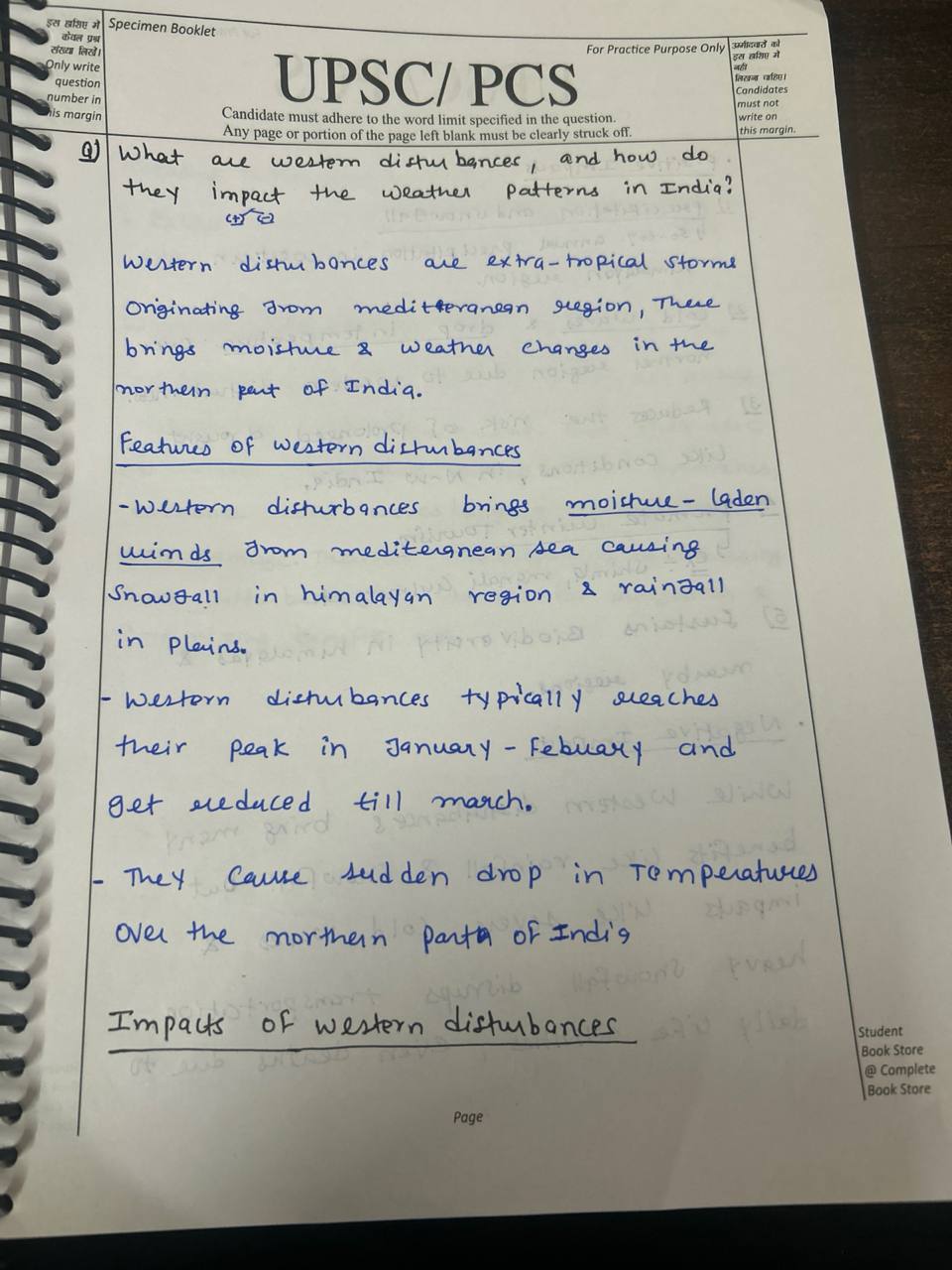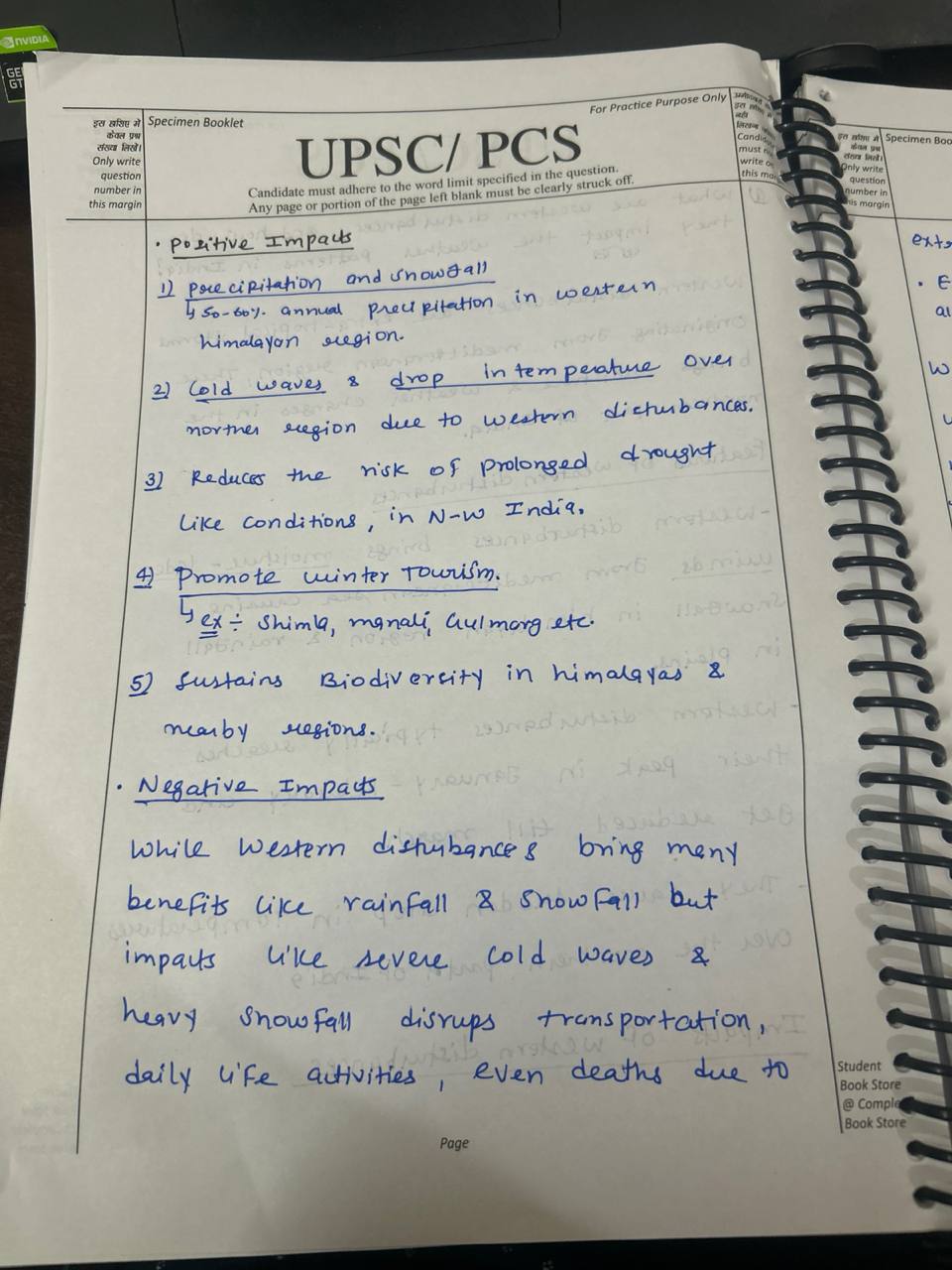Home/Indian Geography/Physical Geography of India/Page 3
Physical Geography of India
Share
312 Followers
36 Answers
307 Questions
Resources & Suggestions
Mains Answer Writing Latest Articles
On: April 18, 2025
Daily Answer Writing Practice Questions (18 April 2025)
Do you agree with the claim that indecision and risk aversion are prevalent issues in Indian bureaucracy? Support your answer with logical reasoning. (150 words) ऐसा कहा जाता है कि भारतीय नौकरशाही में अनिर्णय और जोखिम से बचने की प्रवृत्ति ...
On: April 18, 2025
Comments:
0
Strengthening India’s Cyber Defence
Rising Threats Digital Era Challenges: 2024 marks a significant rise in digital threats, particularly from AI and cyberattacks. Key Issues: Disinformation campaigns. Cyber fraud affecting daily life. Current Major Cyber Threats Ransomware Rampage: Over 48,000 instances of WannaCry ransomware detected ...
On: April 18, 2025
Comments:
0
भारत की साइबर सुरक्षा
बढ़ते खतरे कृत्रिम बुद्धिमत्ता (AI) और साइबर हमले: 2024 में AI और साइबर हमलों के खतरे में वृद्धि। महत्वपूर्ण अवसंरचना पर हमले: डिजिटल हमलों और दुष्प्रचार अभियानों की संभावना बढ़ी है। प्रमुख साइबर खतरें रैनसमवेयर का प्रकोप: 48,000 से अधिक ...

What is land subsidence? Discuss the factors that may have contributed to the subsidence observed in Joshimath, Uttarakhand. (200 words)
Model Answer Land Subsidence Land subsidence refers to the gradual sinking or sudden collapse of the earth's surface due to the removal or displacement of subsurface materials. It can occur naturally due to earthquakes, erosion, or sinkholes, or as a result of human activities like groundwater extraRead more
Model Answer
Land Subsidence
Land subsidence refers to the gradual sinking or sudden collapse of the earth’s surface due to the removal or displacement of subsurface materials. It can occur naturally due to earthquakes, erosion, or sinkholes, or as a result of human activities like groundwater extraction, mining, and infrastructure development.
Factors Contributing to Subsidence in Joshimath, Uttarakhand
In Joshimath, land subsidence is attributed to both natural and anthropogenic factors:
- Built on Ancient Landslide Material: Joshimath is situated on loose sand and stone deposits from an ancient landslide, which lack high load-bearing capacity, making the region vulnerable to subsidence under increasing infrastructure and population pressure.
- Geographic Faults: The region is located along a tectonic fault line where the Indian Plate subducts under the Eurasian Plate, contributing to instability.
- Extreme Weather: Frequent heavy rainfall causes erosion and exacerbates landslides, as seen during the 2013 and 2021 floods.
- Hydroelectric Projects: Construction activities, including tunneling for hydropower projects, have disrupted aquifers, contributing to land subsidence.
- Unplanned Construction: Lack of proper drainage systems and unregulated construction has further aggravated the problem (Source: Indian Institute of Remote Sensing, M.C. Mishra Committee).
See lessWhat is tropical monsoon climate? Discuss its distribution and explain the process of its onset in the Indian subcontinent. (200 words)
Model Answer Tropical Monsoon Climate The tropical monsoon climate is marked by a seasonal reversal of winds and corresponding changes in precipitation. It is characterized by: Temperature: Monthly mean temperatures above 18°C, with summer temperatures ranging from 30-45°C and winter temperatures beRead more
Model Answer
Tropical Monsoon Climate
The tropical monsoon climate is marked by a seasonal reversal of winds and corresponding changes in precipitation. It is characterized by:
Distribution
This climate is found in regions of the Indian subcontinent, Southeast Asia, parts of South America, and northern Australia, notably in countries like India, Burma, Thailand, and Vietnam (Source: Global Climate Distribution).
Onset in the Indian Subcontinent
The Indian monsoon begins in June, driven by factors such as:
The process culminates in rainfall across the subcontinent from June to September.
See lessWhat are local winds? Provide examples and explain how they influence the climate of a region. (200 words)
Model Answer Local Winds Local winds are winds that blow over a small geographical area, typically covering distances from tens to a few hundred kilometers. They are usually short-lived, lasting only several hours to a day, and are influenced by local geographic features like landforms and weather pRead more
Model Answer
Local Winds
Local winds are winds that blow over a small geographical area, typically covering distances from tens to a few hundred kilometers. They are usually short-lived, lasting only several hours to a day, and are influenced by local geographic features like landforms and weather patterns.
Examples of Local Winds and Their Climate Impact
Conclusion
Local winds can significantly affect the climate by altering temperature, humidity, and precipitation patterns, which in turn influences agriculture and daily life.
See lessWhat are western disturbances, and how do they impact the weather patterns in India? (200 words)



See lessDiscuss two widely accepted theories of origin of the earth. Elucidate the position of all planets within the solar system and write the important facts of the earth. [ UPSC PYQ 2024 ]
The two widely accepted theories of origin of the earth are: Nebular hypothesis The earth formed from a cloud of gas and dust, which collapsed under gravity, with the sun forming as it's center. Planetesimal hypotheses The earth formed from the accumulation of small Rocky bodies called planetesimal,Read more
The two widely accepted theories of origin of the earth are:
Nebular hypothesis
The earth formed from a cloud of gas and dust, which collapsed under gravity, with the sun forming as it’s center.
Planetesimal hypotheses
The earth formed from the accumulation of small Rocky bodies called planetesimal, which merged to form larger bodies, eventually becoming the earth.
Position of earth within the solar system
Mercury
Venus
Earth
Mars
Jupiter
Saturn
Uranus
Neptune
The earth is the third planet the sun
See lessBriefly discuss the idea of sustainable development 2030 plan.
The Sustainable Development 2030 plan, also known as the 2030 Agenda for Sustainable Development, is a United Nations initiative adopted by world leaders in 2015. It aims to eradicate poverty, protect the planet, and ensure peace and prosperity for all. *Key Components:* 1. 17 Sustainable DevelopmenRead more
The Sustainable Development 2030 plan, also known as the 2030 Agenda for Sustainable Development, is a United Nations initiative adopted by world leaders in 2015. It aims to eradicate poverty, protect the planet, and ensure peace and prosperity for all.
*Key Components:*
1. 17 Sustainable Development Goals (SDGs)
2. 169 Targets
3. 232 Indicators
*5 Pillars:*
1. People: End poverty, hunger, and ensure well-being
2. Planet: Protect the environment, climate, and natural resources
3. Prosperity: Promote economic growth, innovation, and infrastructure
4. Peace: Ensure peace, justice, and strong institutions
5. Partnership: Foster global cooperation and partnerships
*SDGs:*
1. No Poverty
2. Zero Hunger
3. Good Health and Well-being
4. Quality Education
5. Gender Equality
6. Clean Water and Sanitation
7. Affordable and Clean Energy
8. Decent Work and Economic Growth
9. Industry, Innovation, and Infrastructure
10. Reduced Inequalities
11. Sustainable Cities and Communities
12. Responsible Consumption and Production
13. Climate Action
14. Life Below Water
15. Life on Land
16. Peace, Justice, and Strong Institutions
17. Partnerships for the Goals
*Implementation:*
1. Governments: Develop national plans and policies
2. Private Sector: Invest in sustainable development
3. Civil Society: Engage in advocacy and implementation
4. International Cooperation: Share knowledge, expertise, and resources
*Monitoring Progress:*
1. Voluntary National Reviews (VNRs)
2. Sustainable Development Goals Index (SDGI)
3. United Nations High-Level Political Forum (HLPF)
*Challenges:*
1. Funding
2. Climate Change
3. Inequality
4. Conflict and Instability
5. Data Collection and Monitoring
*Opportunities:*
1. Innovation and Technology
See less2. Global Cooperation
3. Private Sector Engagement
4. Youth Empowerment
5. Integrated Policy Making
How does the Himalayan ranges protect India from extreme climatic conditions?
Himalayan Ranges: India's Natural Shield The towering mountain ranges of the Himalayas forms one of the greatest armor, protecting India from the extreme weather conditions. With its topography, geopolitics and location, it is responsible for a huge proportion of the country’s eco-climate and ecologRead more
Himalayan Ranges: India’s Natural Shield
The towering mountain ranges of the Himalayas forms one of the greatest armor, protecting India from the extreme weather conditions. With its topography, geopolitics and location, it is responsible for a huge proportion of the country’s eco-climate and ecology.
A Natural Barrier Against Cold Winds
-Wind Barrier: The Himalayan mountain ranges act as an effective needless spending for Central Asia lose dry cold winds. The Siberian High as a result does not penetrate the Indian region.
Temperature Regulation: The Himalayas are known to alleviate very high and very low temperatures experienced. In winter, they restrict the movement of warm air hence India is not very cold. In the summer season however, they help to limit the hot and dry winds that are usually present in the Indian subcontinent.
Impact of Monsoons on Water Security
Diversion of Monsoons: The himalkayan range of mountains becomes very important for the Indian monsoon. Most of the winds that come in and are expressed as the monsoon winds in con dryict ‘sea winds’ come from the Indian ocean and interact with the landong activity of the adjoining mountains. This results in rainfall and thanks to the dense clouds, sufficient rains fall on the Indian continent.
-River Systems: The chain of mountains in the Himalayas houses major rivers like Ganga, Indus, Brahmaputra and Yamuna. These rivers help in the sustenance of agriculture and some industries as well as household uses. Hence, In terms of water security, the importance of the Himalayas for India is enormous.
Development of Soil: Weathering of Himalayan range ensures that Indian soils receive certain minerals and nutrients which are eventually beneficial in enhancing agricultural productivity.
Thus, not Himalayas is a mere geographical landform, but it also acts as a barrier which protects the country from harsh climatic extremes, controls the rainfall pattern, and helps maintain the ecosystem of the country. This natural wonder to the people and to the ecology of India is precious and needs to be protected.
Ecological Importance
-Biodiversity Hotspot: The Himalayas are highly regarded as biodiversity hotspots owing to their rich vegetation as well as wildlife. The unique habitats-incuding the biodiversity-rich alpine meadows and even the tropical rain forest protection is important in the ecosystem.
See lessWhat is the phenomenon of “cloudbursts” ? Explain [ 150 words ]
Introduction A cloudburst is an intense and sudden rainfall event, typically localized to a small area, resulting in heavy downpours within a short period. The rainfall rate during a cloudburst often exceeds 100 mm per hour, sometimes causing flash floods and landslides, especially in hilly or mountRead more
Introduction
A cloudburst is an intense and sudden rainfall event, typically localized to a small area, resulting in heavy downpours within a short period. The rainfall rate during a cloudburst often exceeds 100 mm per hour, sometimes causing flash floods and landslides, especially in hilly or mountainous regions.
Body:
Mechanism of Cloudbursts: Cloudbursts occur when warm, moist air rapidly rises due to convection. As the air ascends, it cools, and the moisture condenses to form clouds. In certain conditions, particularly in regions with steep topography, the clouds are unable to release moisture gradually, leading to the sudden and concentrated release of rain.
Factors contributing to cloudbursts include:
Orographic Lift: In mountainous areas, air masses are forced upwards when they encounter hills or mountains. This increases condensation and can lead to the rapid release of rain.
E.g. Leh cloudburst in 2010
Temperature Differences: Sharp contrasts in temperature can lead to strong upward air currents, which trap moisture in the clouds, eventually leading to a cloudburst.
E.g. In Leh, Ladakh (2022), a cloudburst occurred due to a temperature-induced thunderstorm.
Localized Thunderstorms: Thunderstorms that develop due to intense heating can also trigger cloudbursts, with localized areas experiencing intense downpours.
E.g. In July 2021, a cloudburst near Amarnath Cave in Jammu and Kashmir
Effects of Cloudbursts:
Conclusion
Cloudbursts have become a significant concern in the Indian subcontinent, due to changing climate patterns and increasing human habitation in vulnerable areas and there is a need for robust urban planning and sustainable infrastructure development strategies to minimize damage.
See lessDiscuss the Process of soil formation [ 5 marks & 150 words ] UPSC 2024 PYQ
Soil formation is a continuous and complex process that involves several factors working together over time. The key processes involved are: 1. Weathering of Parent Material: Soil formation begins with the weathering of rocks (parent material) through physical, chemical, and biological processes. PhRead more
Soil formation is a continuous and complex process that involves several factors working together over time. The key processes involved are:
1. Weathering of Parent Material:
Soil formation begins with the weathering of rocks (parent material) through physical, chemical, and biological processes. Physical weathering breaks rocks into smaller pieces, while chemical weathering alters minerals, and biological weathering involves the action of organisms like plants and microorganisms.
2. Climate Influence:
Climate, particularly temperature and rainfall, plays a significant role in soil formation. High rainfall accelerates weathering and leaching, while temperature influences the rate of chemical reactions. In hot and wet climates, soils tend to be more weathered and leached.
3. Organisms:
Plants, animals, and microorganisms contribute organic matter that enriches the soil, influencing its texture, structure, and fertility. Decomposed organic material forms humus, which improves soil moisture retention and nutrient availability.
4. Topography:
The shape and slope of the land affect water drainage and erosion, influencing soil development. Steep slopes may lead to soil erosion, while flat areas accumulate soil.
5. Time:
Over long periods, soils evolve, and different horizons (layers) develop, contributing to the soil’s profile and fertility.
This process results in a variety of soil types with unique characteristics based on these influencing factors.
See lessWhy do Indian cities struggle with monsoon preparedness?
As India braces for the annual monsoon season, effective preparedness is crucial to mitigate flooding, landslides and disruptions. A comprehensive approach integrating infrastructure upgrades, early warning systems, community engagement and climate resilience can minimize risks, protect lives and enRead more
As India braces for the annual monsoon season, effective preparedness is crucial to mitigate flooding, landslides and disruptions. A comprehensive approach integrating infrastructure upgrades, early warning systems, community engagement and climate resilience can minimize risks, protect lives and ensure seamless urban functionality during the rainy months.
Indian cities struggle with monsoon preparedness –
Effective monsoon preparedness in Indian cities requires a multi faceted approach, integrating infrastructure upgrades, climate resilience and community engagement to safeguard vulnerable populations and mitigate the impacts of extreme weather events.
See less